

Sociological Spotlight on Current Affairs in the Global Age. The few, the proud, the very rich. Sylvia Allegretto, labor economist, Center on Wage and Employment Dynamics | 12/5/11 | | Much of the current political and popular discourse has focused on inequalities that exist in the U.S.
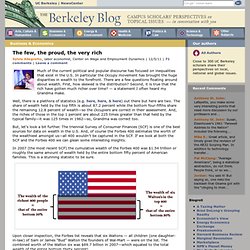
In particular the Occupy movement has brought the huge disparities in wealth to the forefront. Three ways to dissimulate the conflict between the 1% and the 99% (#OccupyWallStreet update) Excerpted from Jodi Dean: ‘After the movement was impossible to ignore, after the protesters had demonstrated determination and the police had reacted with orange containment nets and pepper spray, other efforts to efface the fundamental division opened up by Occupy Wall Street emerged.
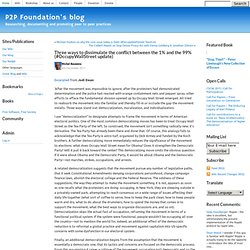
All tried to reabsorb the movement into the familiar and thereby fill-in or occlude the gap the movement installs. Three ways stand out: democratization, moralization, and individualization. I use “democratization” to designate attempts to frame the movement in terms of American electoral politics. One of the most common democratizing moves has been to treat Occupy Wall Street as the Tea Party of the left. 13 Unusual Facts About the Saddest Photo in the Great Depression Altucher Confidential. Posted by James Altucher Last night I was on CNBC’s Fast Money.

Everyone seems to want to talk about the impending Great Depression: Europe fails, contagion spreads it to here, all of our banks fail, everyone loses their jobs, blah, blah, blah. The world feels like it’s ending. But it’s not. #OccupyWallStreet Teach-in by William K Black: unindicted fraud and the 1% The British 1 Percent. Grand Strategy Annex - Meritocracy or birth lottery? Why ‘Occupy Wall Street’ Makes Sense: Lessons Economists Could Learn from the 99% EmailShare 0EmailShare (guest blog) by Joe Mcivor Moral Majority?
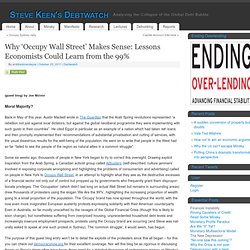
Back in May of this year, Austin Mackell wrote in The Guardian that the Arab Spring revolutions represented “a rebellion not just against local dictators, but against the global neoliberal programme they were implementing with such gusto in their countries”. He cited Egypt in particular as an example of a nation which had taken IMF loans and then promptly implemented their recommendations of substantial privatisation and cutting of services, with the usual disastrous results for the well-being of the population. He went on to write that people in the West had so far “failed to see the people of the region as natural allies in a common struggle”. Some six weeks ago, thousands of people in New York began to try to correct this oversight. Lesson #1. Lesson # 2. There are two problems with this. Lesson # 3. India’s Middle Class Appears to Shed Political Apathy.
When politics stops being "low," the middle class-fueled "progressivism" kicks in. Global Wealth Distribution. As we have discussed, from 1979 to 2007, inflation-adjusted incomes of the top 1 percent of households increased significantly versus the rest of the wage earners (i.e., the remaining 99%).
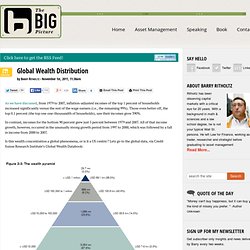
Those even better off, the top 0.1 percent (the top one one-thousandth of households), saw their incomes grow 390%. In contrast, incomes for the bottom 90 percent grew just 5 percent between 1979 and 2007. All of that income growth, however, occurred in the unusually strong growth period from 1997 to 2000, which was followed by a fall in income from 2000 to 2007. Is this wealth concentration a global phenomena, or is it a US centric? Lets go to the global data, via Credit Suisse Research Institute’s Global Wealth Databook: Source: Credit Suisse, Research Institute. #OWS, The Other 98%, US Uncut & Rebuild the Dream: A Look at the Shoes That Didn't Drop. Times Square, Occupy Wall Street rally, Saturday, October 15, 2011.

Photo by Micah L. Sifry Here's a question to ponder: Did Occupy Wall Street succeed simply because it was non-hierarchical in method, had smart framing in tune with public anger about the economy and Wall Street, and made really effective use of social media? If that was all it took to ignite a self-organizing movement for economic justice, then why didn't a very similar effort, called "The Other 98%," take off last year? Why didn't the US Uncut movement, a spin-off of an ongoing street protest movement in England, take off here this past winter? Interview: Economist Who Co-discovered "the 99%" On The Occupy Wall Street Movement That Followed His Research. 99 Percent Movement. Nature is the 99%, too. What if rising sea levels are yet another measure of inequality?

What if the degradation of our planet's life-support systems - its atmosphere, oceans and biosphere - goes hand in hand with the accumulation of wealth, power and control by that corrupt and greedy 1 per cent we are hearing about from Zuccotti Park? What if the assault on America's middle class and the assault on the environment are one and the same? It's not hard for me to understand how environmental quality and economic inequality came to be joined at the hip.
In all my years as a grassroots organiser dealing with the tragic impact of degraded environments on public health, it was always the same: Someone got rich and someone got sick. In the struggles that I was involved in to curb polluters and safeguard public health, those who wanted curbs, accountability and precautions were always outspent several times over by those who wanted no restrictions on their effluents.
Democracy 101. David J. Dunn, PhD: "It's the Democracy, Stupid!": The "Vague" Goals of the Other 99% Some conservative punditry has claimed to be flummoxed by the "vague" goals of the "Occupy" protests happening across the country.

I will grant that there is some truth to this complaint. In their early days, "patchwork" protests often lack a clear and unified voice. Still, no one with a basic understanding of history or an ounce of empathy should be surprised or confused by the outrage of "The Other 99%. " Perhaps an example will make things clearer. For several summers I have taught a course on "Consumerism in Society" to gifted and talented teenagers.
I do it this way because in many ways life is "rigged. " Why the 99% Can't Be Co-opted. Protesters at "Occupy Wall Street" camp, Liberty SquarePhoto Credit: Sarah Jaffe October 21, 2011 | Like this article?
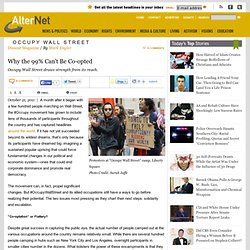
Join our email list: How the 99 Percent Really Lost Out - in Far Greater Ways Than the Occupy Protesters Imagine. "Property is theft," French anarchist Pierre-Joseph Proudhon famously declared in 1840 - a judgment clearly shared by many of those involved in the occupations in the name of the 99 percent around the country, and especially when applied to Wall Street bankers and traders.
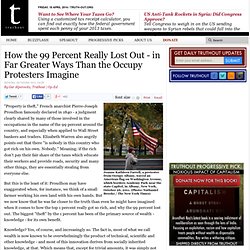
Elizabeth Warren also angrily points out that there "is nobody in this country who got rich on his own. Nobody. " We Are The 98% I feel little more than contempt for those who have ridiculed the "We Are The 99%" slogan of the occupy protesters. Some of these apologists for the status quo are more despicable than others. Those who have a reservation in Dante's inner circles of Hell tell us that only 13% of the 1% work on Wall Street (in finance). They thus feel entitled to conclude that the protests are misplaced and misinformed.